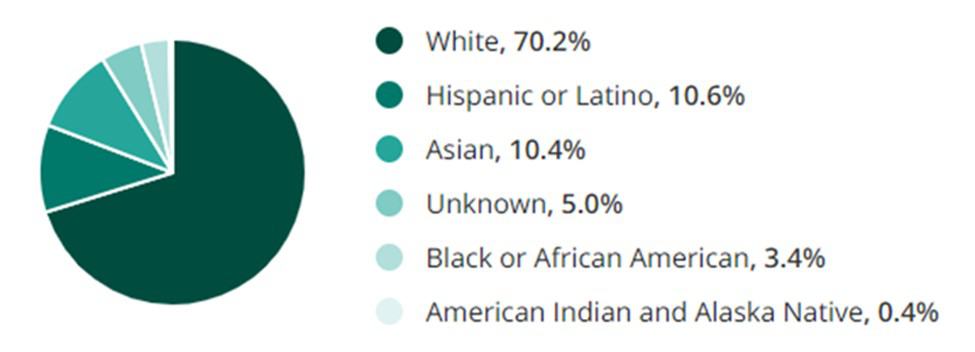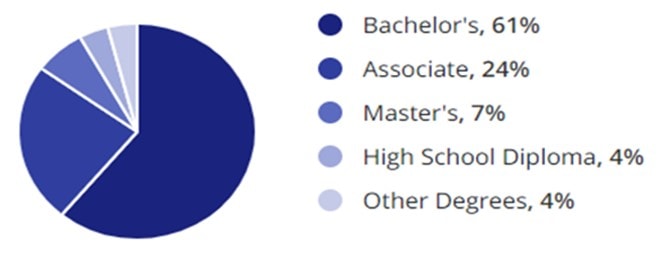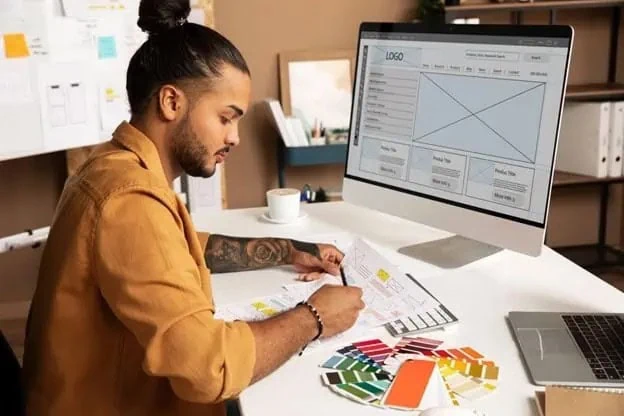Welcome to your ultimate guide to carving out a successful career in design. The design industry, with its diverse array of roles from interior design assistant jobs to remote instructional design jobs, offers a world of creativity and innovation to explore. This guide serves as your roadmap, whether you’re stepping into the dynamic landscape of entry-level designer jobs, UX designer jobs, or aiming to scale new heights in more established design roles.
Navigating the design field requires a keen eye for aesthetics and an understanding of the market demand, technological advancements, and, most importantly, the audience’s diverse needs. This guide will give you a closer look at the essential educational pathways, expanding areas of expertise, and evolving job trends within the design sector.
Moreover, our discussion on salary and hiring trends will provide insights into what to expect and how to position yourself competitively. We’ll also dive into the demographics of design professionals in the United States, highlighting the importance of diversity and inclusion in fostering a vibrant and dynamic industry.
Embark on this journey with us as we delve deep into the world of design jobs, equipping you with the knowledge and tools you need to succeed in this creative discipline.
Educational Requirements
Starting a career in design requires a solid educational background. Most design roles require a bachelor’s degree in a relevant field. This could be graphic design, industrial design, interior design, or similar areas. While a degree forms the basis of your expertise, obtaining certifications can lift your profile, especially in specialized fields. For instance, earning a user experience (UX) design certification significantly benefits those looking into digital design landscapes like entry-level UX designer jobs.
Certificates aren’t always a must-have, but they give you an advantage in specific areas. Highlighting certifications in emerging fields, such as UX design or sustainable design practices, can make your resume stand out. Whether you’re eyeing interior design assistant jobs or aiming for remote instructional design jobs, positioning yourself with formal education and targeted certifications can propel you ahead in the competition.
Areas of Expertise
The field of design is vast, comprising several areas of expertise, each with its unique focus and skills. Knowing where your interests lie can help you navigate your career path effectively. Here are some prominent areas:
- Graphic Design: Involves creating visual content to communicate messages. Graphic designers use typography, images, color, and layout to meet specific user needs.
- Industrial Design: Focuses on developing concepts and designs for manufactured products. This can range from small items like toys to large industrial machinery.
- Interior Design: Enhances the function and quality of interior spaces. Interior designers consider aesthetics, safety, and comfort to create engaging and livable environments.
- Fashion Design: Involves creating clothing and accessories. Fashion designers blend artistic vision with market trends to produce wearable art.
- UX/UI Design: Aim at improving user satisfaction with a product by enhancing usability, accessibility, and enjoyment in the interaction with the product. This area has seen significant growth with the rise of digital products.
The design industry offers many opportunities for creative and tech-savvy professionals, from traditional roles to emerging digital domains like remote instructional design jobs and UX design. Understanding these areas can empower job seekers to align their education and skills with the specialized demands of their chosen field.
Demographics in the United States
Ethnicity/Race:
The landscape of design jobs in the U.S. showcases a mix of ethnicities and races, contributing to the richness of creative viewpoints. Here’s a snapshot of the diversity within the sector:
- White: 70.2%
- Hispanic or Latino: 10.6%
- Asian: 10.4%
- Black or African American: 3.4%
- Other: 5%
- Native American and Alaska Native: 0.4%
The design industry is actively taking steps towards greater inclusivity, aiming for a workforce that better reflects the varied demography of the broader U.S. population.

Gender:
The gender distribution in design careers presents a relatively balanced landscape, with the following representation:
- Male: 56.9%
- Female: 43.1%
Efforts are ongoing to level the playing field, ensuring equal opportunities and representation for all genders in every aspect of design work.

Age:
Design jobs attract a dynamic range of ages, highlighting the industry’s appeal to young creatives and seasoned professionals. With an estimated average age of 29 years, the sector is vibrant, fostering a blend of fresh perspectives and experienced insight.

The demographic data underlines the design sector’s evolving nature, reflecting societal trends towards diversity and inclusivity. By understanding these trends, employers and job seekers can better navigate the field of design jobs, ensuring that the profession remains accessible and representative of all.
Salary Trends
Compensation in the design industry varies widely, factoring in specialization, experience, and geographical location. On average, salaries in U.S. design jobs range from $45,000 to $120,000 annually. Here are some factors influencing these figures:
- Specialization: Niche roles such as UX/UI designers or instructional designers often command higher salaries due to the specialized skill set they bring to the table.
- Experience: Seasoned professionals with years of experience can expect salaries on the higher end of the spectrum, while those in entry-level UX designer jobs might start with lower compensation.
- Location: Geographic location plays a significant role in salary trends. Designers in major metropolitan areas typically earn more due to the higher cost of living and increased demand for design services.
Despite these variables, the demand for talented designers across various specialties—from traditional roles like graphic design to digital roles like remote design jobs—remains strong, underpinning the competitive salaries in the industry.
Hiring Trends
The design industry is witnessing robust hiring trends driven by the increasing recognition of the importance of design in business and technology. A projected growth rate of 6% over the next five years highlights the sector’s vitality. Here are some key trends shaping the hiring landscape:
- Digital Expansion: There’s a surge in demand for skills in digital domains, particularly for roles like UX/UI design and instructional design jobs. This reflects the growing importance of online platforms and digital interactions.
- Sustainability: There is a growing emphasis on sustainable design practices across industries. Designers who can integrate eco-friendly principles into their work are increasingly sought after.
- Remote Work: Remote and flexible work arrangements are becoming more common, extending to design roles. This shift allows a broader talent pool to access opportunities regardless of location.
These trends indicate not just an increase in job opportunities but also a shift in the types of roles available, requiring designers to adapt and skill up in response to the evolving needs of the industry.
Education Levels
While a bachelor’s degree remains the standard entry-level requirement for most design careers, the education landscape within the industry is diverse. Continuous learning is a hallmark of the sector, with professionals often pursuing further education to keep up with emerging trends and technologies. Here’s a breakdown:
- Bachelor’s Degree: The foundational degree for establishing a career in design. Relevant fields include graphic design, industrial design, and interior design.
- Master’s Degree: Some professionals pursue advanced degrees to specialize further or to transition into academia or high-level consultancy roles.
- Certifications: Certifications in areas like UX design, sustainable design, or specific software skills can enhance a designer’s qualifications and appeal to prospective employers.
- Workshops and Online Courses: Ongoing education through short courses or workshops, especially those focused on new technologies or methodologies, supports career development and adaptability.
This varied educational spectrum reflects the dynamic nature of design jobs, emphasizing the importance of lifelong learning to remain competitive and innovative in the field.

Skills in Demand
The evolution of the design industry has led to a diverse range of skills becoming highly sought after by employers. Here are the essential skills that stand out in the current market:
- Technical Proficiency: Mastery of design software, such as Adobe Creative Suite, Sketch, and Figma, is essential. Being up-to-date with the latest tools can significantly enhance a designer’s efficiency and creativity.
- UX/UI Design: With digital products becoming increasingly central to our lives, user experience (UX) and user interface (UI) design skills are in high demand. Designers who can create intuitive and user-friendly interfaces are highly valued.
- Creative Thinking: Creativity remains at the core of design. The ability to think outside the box and develop innovative solutions is crucial.
- Communication Skills: Designers often work in teams and collaborate with clients. Effective communication ensures that ideas are clearly conveyed and projects meet client expectations.
- Time Management: Managing projects efficiently and meeting deadlines is essential, especially in fast-paced environments or when handling multiple projects.
These skills are applicable across various design roles, from traditional graphic design positions to more niche areas like entry-level UX designer jobs. Staying competitive in the design job market requires combining technical, creative, and soft skills.
Current & Future Design Jobs Outlook
The outlook for design jobs is both bright and evolving. Integrating design into business strategy and digital transformation across industries drives substantial growth in this field. Here’s what the future looks like:
- Strong Growth: With a projected 6% growth over the next five years, opportunities in design are expanding. This growth is not just limited to traditional areas but also emerging fields like UX/UI design and sustainable design.
- Digital Focus: The shift towards digital platforms underscores a rising demand for UX/UI designers who can create engaging online experiences. This trend likely will persist as more businesses recognize the value of well-designed digital interfaces.
- Sustainability and Inclusivity: There’s an increasing emphasis on sustainability and inclusivity in design. Designers who can incorporate these principles into their work will be in high demand.
- Remote Opportunities: The rise of remote work continues to open up new possibilities for designers and allows professionals to work from anywhere, broadening job access.
The future for those seeking design jobs looks promising, with shifts towards digital and sustainable designs paving the way for innovative work opportunities. Continuously updating skills and adapting to industry changes will be necessary for professionals aiming to thrive in this dynamic landscape.
FAQ’s
Do I need a bachelor’s degree to pursue a career in design?
Yes. Most design roles typically require a bachelor’s degree in a related field. However, equivalent experience and a strong portfolio can also be significant for specific positions or freelance opportunities.
What design specialization is most in demand?
Currently, UX/UI design is among the most in-demand specializations, driven by the increasing focus on digital experiences. Skills in sustainable and inclusive design are also in rising demand.
Can I work remotely in design jobs?
Absolutely. Many design roles offer remote opportunities, particularly in digital-focused areas like UX/UI and instructional design. Flexibility in location can open up a wider range of job prospects.
How often do design professionals need to update their skills?
Design is a constantly evolving field, so continuous learning is crucial. Keeping up with new software, design trends, and methodologies is essential for staying competitive in the job market.
Is it possible to transition into design from a different career?
Yes, many people have successfully transitioned into design from other fields. A strong portfolio, relevant education or certifications, and the willingness to learn are vital factors for such a transition.
Addressing these frequently asked questions helps clarify common concerns and misconceptions about pursuing a career in the design industry, providing valuable insights for aspiring designers.
Additional Resources
Numerous resources are available for those looking to deepen their understanding of design or enhance their career prospects. Here are some valuable platforms and organizations offering guidance, learning materials, and networking opportunities:
- The American Institute of Graphic Arts (AIGA) offers a wealth of resources for graphic designers, including events, professional development, and job boards.
- The Industrial Designers Society of America (IDSA) provides information on industrial design, including competitions, scholarships, and a comprehensive design job board.
- The User Experience Professionals Association (UXPA) supports UX professionals through mentorship, education, and networking opportunities.
- For those interested in sustainability in design, the o2 International Network for Sustainable Design offers resources and a community focused on environmentally responsible design practices.
- The edX platform offers online courses from top universities and institutions worldwide, including design-related courses that can help expand your knowledge and skills from anywhere.
Exploring these resources can equip you with the tools and network needed to succeed and stay competitive in the dynamic design field.
Conclusion
Embarking on a career in design is an exciting journey filled with opportunities for creativity and innovation. Whether you’re just starting out or looking to further your career, understanding the educational requirements, areas of expertise, demographics, salary, hiring trends, and the current and future outlook of design jobs is crucial. Equipping yourself with in-demand skills and continuously updating your knowledge can help you stand out in this competitive field.
We invite you to Join Diversity Employment to take the next step in your design career. By becoming a part of our community, you’ll gain access to a wealth of resources, diversity jobs, and a network of professionals committed to advancing diversity and inclusion within the design industry. Let’s work together towards creating more inclusive, creative, and innovative workplaces.




